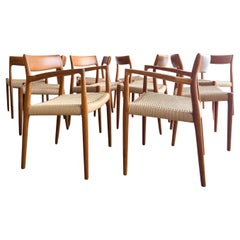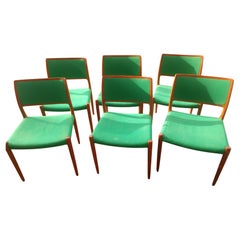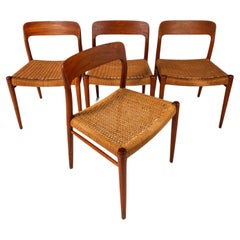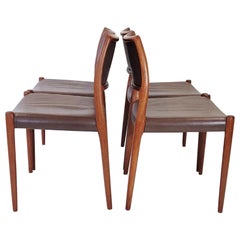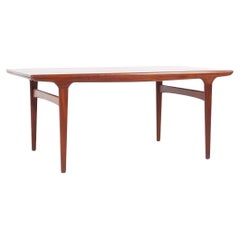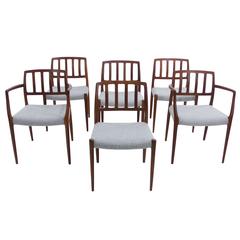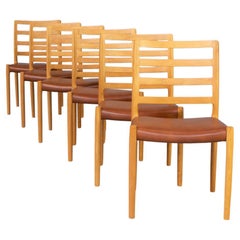Jl Moller Teak Dining Chairs
Vintage 1950s Danish Mid-Century Modern Dining Room Chairs
Papercord, Birch, Teak
Vintage 1960s Danish Mid-Century Modern Dining Room Chairs
Teak
Vintage 1960s Danish Mid-Century Modern Dining Room Chairs
Papercord, Teak
Vintage 1950s Danish Mid-Century Modern Dining Room Chairs
Fabric, Teak
Vintage 1970s Danish Scandinavian Modern Dining Room Chairs
Wool, Teak
Vintage 1950s Danish Mid-Century Modern Dining Room Chairs
Papercord, Teak
Mid-20th Century Danish Scandinavian Modern Dining Room Chairs
Papercord, Teak
Vintage 1960s Danish Mid-Century Modern Dining Room Chairs
Teak
Vintage 1950s Danish Scandinavian Modern Dining Room Chairs
Fabric, Teak
20th Century Dining Room Chairs
Teak
Vintage 1970s Danish Mid-Century Modern Dining Room Tables
Teak
Mid-20th Century Danish Mid-Century Modern Dining Room Chairs
Teak
Vintage 1960s Danish Mid-Century Modern Dining Room Chairs
Papercord, Teak
20th Century Dining Room Chairs
Teak
Vintage 1960s Danish Mid-Century Modern Dining Room Chairs
Leather, Wood, Teak
20th Century Dining Room Chairs
Teak
Vintage 1960s Danish Mid-Century Modern Chairs
Teak
Mid-20th Century Danish Mid-Century Modern Dining Room Chairs
Leather, Teak
Vintage 1960s Danish Scandinavian Modern Dining Room Chairs
Papercord, Teak
Vintage 1960s Danish Scandinavian Modern Side Chairs
Papercord, Teak
Vintage 1960s Danish Mid-Century Modern Dining Room Chairs
Leather, Wood, Teak
Vintage 1960s Danish Scandinavian Modern Side Chairs
Papercord, Teak
20th Century Dining Room Chairs
Teak
Vintage 1950s Danish Mid-Century Modern Chairs
Wood, Leather
Mid-20th Century Danish Mid-Century Modern Dining Room Tables
Teak
Vintage 1960s Danish Mid-Century Modern Armchairs
Teak
Recent Sales
Mid-20th Century Danish Scandinavian Modern Dining Room Chairs
Teak
Vintage 1970s Danish Mid-Century Modern Dining Room Chairs
Leather, Oak
Vintage 1950s Danish Scandinavian Modern Dining Room Chairs
Teak
Vintage 1960s Danish Mid-Century Modern Dining Room Chairs
Papercord, Teak
Vintage 1960s Danish Mid-Century Modern Dining Room Chairs
Papercord, Teak
Mid-20th Century Danish Mid-Century Modern Chairs
Leather, Teak
Vintage 1960s Danish Scandinavian Modern Chairs
Leather, Teak
Mid-20th Century Danish Mid-Century Modern Sideboards
Teak
Mid-20th Century Unknown Mid-Century Modern Dining Room Chairs
Suede, Teak
Vintage 1950s Danish Dining Room Chairs
Vintage 1970s Danish Mid-Century Modern Dining Room Chairs
Teak, Upholstery
Vintage 1980s Danish Scandinavian Modern Dining Room Chairs
Upholstery, Teak
Vintage 1960s Danish Mid-Century Modern Dining Room Chairs
Teak
Vintage 1960s Danish Scandinavian Modern Dining Room Chairs
Upholstery, Teak
Vintage 1960s Danish Scandinavian Modern Dining Room Chairs
Teak, Upholstery
Vintage 1960s Danish Scandinavian Modern Dining Room Chairs
Teak, Faux Leather
Vintage 1960s Danish Mid-Century Modern Dining Room Chairs
Papercord, Teak
Vintage 1960s Danish Mid-Century Modern Dining Room Chairs
Papercord, Teak
Vintage 1960s Danish Scandinavian Modern Dining Room Chairs
Teak
Vintage 1960s Danish Scandinavian Modern Dining Room Chairs
Faux Leather, Teak
Vintage 1950s Danish Dining Room Chairs
Teak, Upholstery
20th Century Danish Mid-Century Modern Dining Room Chairs
Fabric, Teak, Wood
Vintage 1960s Danish Mid-Century Modern Dining Room Chairs
Papercord, Teak
Mid-20th Century Danish Scandinavian Modern Dining Room Chairs
Papercord, Teak
Vintage 1960s Danish Scandinavian Modern Dining Room Chairs
Papercord, Teak
Vintage 1960s Danish Mid-Century Modern Chairs
Teak
Vintage 1960s Danish Dining Room Chairs
Teak
Vintage 1960s Danish Scandinavian Modern Dining Room Chairs
Upholstery, Teak
Mid-20th Century Danish Scandinavian Modern Dining Room Chairs
Teak
Vintage 1960s Danish Scandinavian Modern Dining Room Chairs
Fabric, Teak
Vintage 1960s Danish Dining Room Chairs
Teak, Leather
Vintage 1950s Danish Scandinavian Modern Dining Room Chairs
Papercord, Teak
Vintage 1960s Danish Mid-Century Modern Dining Room Chairs
Teak, Leather
20th Century Danish Dining Room Chairs
Teak
Mid-20th Century Danish Mid-Century Modern Dining Room Chairs
Teak
Vintage 1970s Danish Mid-Century Modern Dining Room Chairs
Oak, Teak
Mid-20th Century Danish Mid-Century Modern Dining Room Chairs
Leather, Teak
Vintage 1980s Danish Scandinavian Modern Dining Room Chairs
Papercord, Maple
Mid-20th Century Danish Mid-Century Modern Dining Room Chairs
Teak, Papercord
Vintage 1950s Danish Mid-Century Modern Dining Room Chairs
Teak, Papercord
Vintage 1960s Danish Scandinavian Modern Dining Room Chairs
Papercord, Teak
Vintage 1960s Danish Scandinavian Modern Dining Room Chairs
Papercord, Teak
Vintage 1960s Mid-Century Modern Dining Room Chairs
Wool, Teak
Vintage 1960s Danish Scandinavian Modern Dining Room Chairs
Fabric, Teak
Vintage 1960s Danish Mid-Century Modern Dining Room Chairs
Teak
Vintage 1970s Danish Mid-Century Modern Dining Room Chairs
Leather, Teak
Vintage 1950s Danish Scandinavian Modern Dining Room Chairs
Papercord, Teak
Vintage 1970s Danish Scandinavian Modern Dining Room Chairs
Papercord, Teak
Vintage 1960s Danish Dining Room Chairs
Teak
Vintage 1960s Danish Dining Room Chairs
Vintage 1960s Danish Scandinavian Modern Dining Room Chairs
Fabric, Rosewood
Vintage 1960s Danish Dining Room Chairs
Teak
Vintage 1960s Danish Dining Room Chairs
Teak, Leather
Vintage 1960s Danish Scandinavian Modern Dining Room Chairs
Papercord, Teak
Vintage 1970s Danish Mid-Century Modern Dining Room Chairs
Teak, Papercord
Vintage 1970s Danish Mid-Century Modern Dining Room Chairs
Teak, Papercord
Vintage 1970s Danish Mid-Century Modern Dining Room Chairs
Papercord, Teak
Vintage 1960s Danish Mid-Century Modern Dining Room Chairs
Leather, Wood, Teak
People Also Browsed
2010s Danish Scandinavian Modern Dining Room Chairs
Oak
2010s South African Minimalist Night Stands
Wood
2010s Table Lamps
Iron
21st Century and Contemporary American Mid-Century Modern Wall Lights an...
Enamel, Brass
2010s Danish Scandinavian Modern Dining Room Chairs
Oak
21st Century and Contemporary Swedish Mid-Century Modern Table Lamps
Textile
21st Century and Contemporary Scandinavian Chairs
Oak
2010s Danish Scandinavian Modern Dining Room Chairs
Oak
Mid-20th Century Italian Mid-Century Modern Dining Room Tables
Marble, Steel
Vintage 1960s Danish Mid-Century Modern Dining Room Chairs
Papercord, Teak
Vintage 1960s Danish Scandinavian Modern Dining Room Chairs
Cotton, Cord, Rosewood
Vintage 1940s French Art Deco Dining Room Tables
Elm
21st Century and Contemporary Italian Mid-Century Modern Chandeliers and...
Metal, Aluminum, Brass
21st Century and Contemporary Italian Mid-Century Modern Dining Room Tables
Travertine
21st Century and Contemporary Canadian Mid-Century Modern Chandeliers an...
Brass
2010s Italian Mid-Century Modern Table Lamps
Brass
Jl Moller Teak Dining Chairs For Sale on 1stDibs
How Much are Jl Moller Teak Dining Chairs?
Finding the Right Dining-room-chairs for You
No matter what your dream dining experience looks like, there is a wide-ranging variety of vintage, new and antique dining room chairs on 1stDibs. Find upholstered dining room chairs, wood dining room chairs and more to outfit any space designated for a good meal, be it in your home or in the great outdoors.
In the early 18th century, most dining room tables and other furniture was designed to look masculine. In America, dining rooms weren’t even much of a concept until the late 1700s, when a space set aside specifically for dining became a part of the construction of homes for the wealthy. Dining room chairs of the era were likely made of walnut or oak. In Europe, neoclassical dining chairs emerged during the 1750s owing to nostalgia for classical antiquity, while the curving chair crests of Queen Anne furniture in the United States preceded the artistically bold seat backs that characterized the Chippendale chairs that followed. If there weren't enough dining chairs at suppertime in the American colonies, men were prioritized and women stood.
In the dining rooms of today, however, there is enough space for everyone to have a seat at the table. Modern styles introduce innovative design choices that play with shape and style. Icons of mid-century modern dining room chairs are plentiful: With its distinctive bentwood back, there is the DCW dining chair by Charles and Ray Eames, while Hans Wegner's timeless classic, the Wishbone chair, remains relevant and elegant decades after its debut. Stefano Giovannoni's White Rabbit dining chairs, in their lovable polyethylene biomorphism, reinvent what dining can look like.
Today's wide range of dining room chairs also means that they can now be styled in different ways, bringing functionality and fun to any sumptuous dining space. No longer do tables have to be accompanied by a matching set of seats. Skillfully mixing and matching colors and designs allows you to showcase your personality without sacrificing the cohesion of a given space.
By furnishing your dining room with cozy chairs — vintage, antique or otherwise — family time can extend far beyond mealtime. The plush upholstery of Victorian-style dining room chairs is perfect for game nights that stretch from dinner to midnight snack. Outdoor tables and dining chairs can also present an excellent opportunity for bonding and eating — what goes better with a delicious meal than fresh air, anyway?
Whether you prefer your chairs streamlined and stackable or ornate and one of a kind, the offerings on 1stDibs will elevate your mealtime and beyond.
